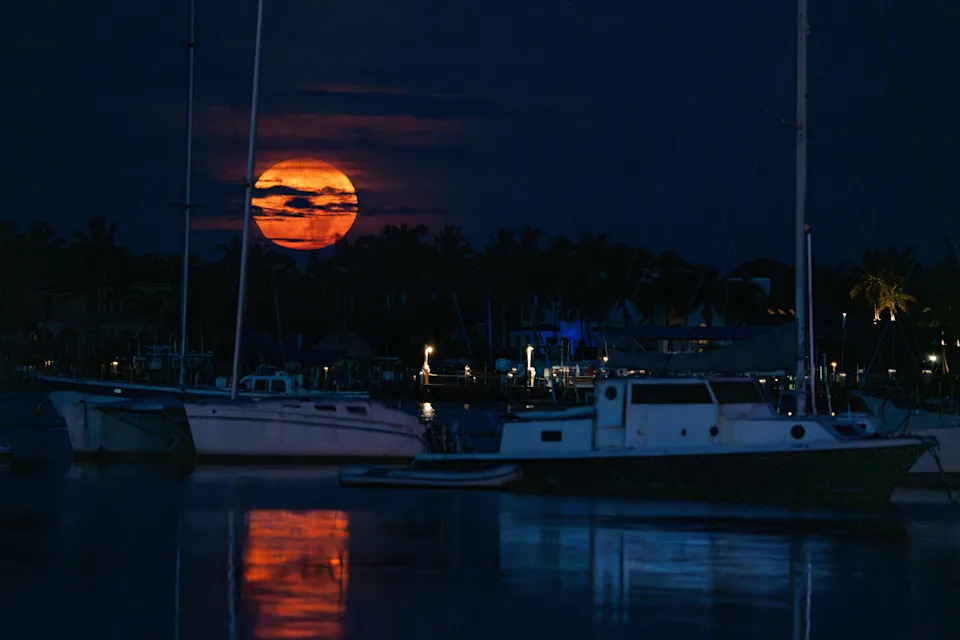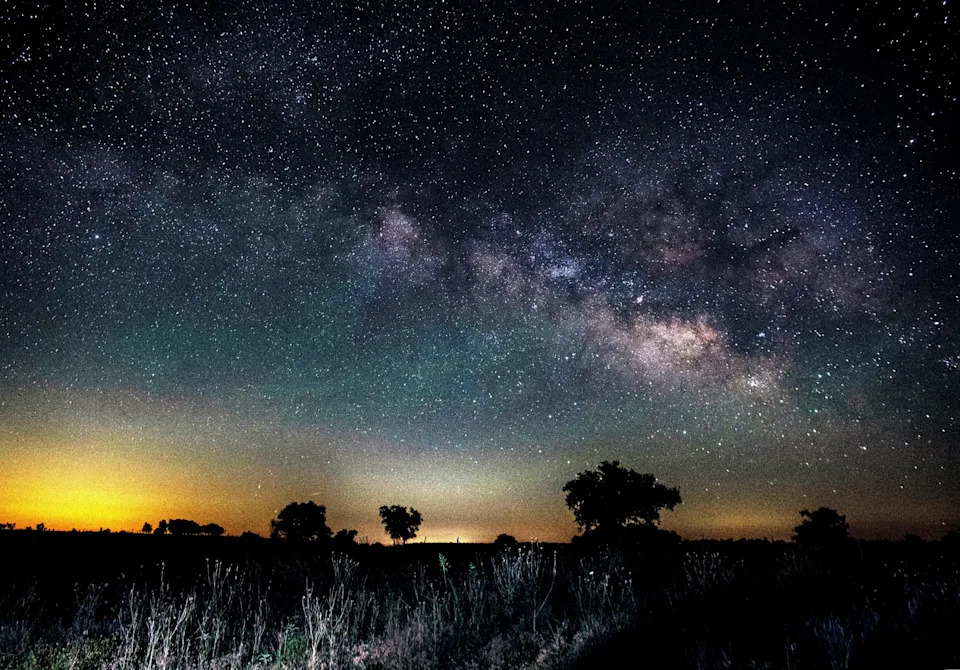Did you miss the full Buck moon? Enjoy Friday's moon illusion thanks to Louisville's clearer skies
If you missed Thursday's full Buck moon shining over Louisville, not to worry! Friday night's moon will be shining at 99% illumination, according to NASA.
Louisville residents also should have a fairly good view of the moon thanks to mostly clear skies, which can help with experiencing the "Moon Illusion."
Here's what Kentucky skywatchers should know.
Story continues after photo gallery.
Is there a full moon tonight? No, but it shines brightly Friday, July 11 anyway. Here's when
According to the Old Farmer's Almanac, moonrise for the Louisville area will happen by roughly 10:11 p.m. Friday, July 11, crossing the meridian at 2:12 a.m. before setting at 6:56 a.m. Saturday.
You cancheck moonrise and moonset times for your zip codeby visiting the Old Farmer's Almanac online.
Why does the moon look big? What to know about the 'Moon Illusion'
There's something neat that happens when the full moon is closer to the horizon; it looks HUGE. Especially when you glimpse it poking out above a treeline, mountains, buildings or bodies of water. But here's the thing: It's an optical illusion.
The full moon isn't larger when it's near the horizon any more than when it's positioned directly overhead, writes NASA. Our brain tricks us into thinking the moon is bigger because of how we perceive its depth in relation to the other objects around it. This phenomenon is known as the "Moon Illusion."
How to spot the 'Moon Illusion' for yourself
You can prove the illusion for yourself by changing the way you look at the moon:
First, look at the full moon normally when it's close to the horizon. Next, gaze at it through a cardboard tube, blocking out everything except the moon.
Or try looking at the full moon while upside down, which can be done if you bend over and look back between your legs, or, if you've got it in your yard, leaning over backwards while seated on a swing.
In either case, the moon won't appear as big as it once seemed.
July's full moon will appear low in the sky. Here's why
July's full moon is going to appear lower on the horizon. The reason is that the Earth is in the midst of "a major lunar standstill,"which has to do with the moon's orbit around the Earth.
"It’s all about the inclination of the moon’s orbit, which undergoes an 18.6-year cycle," writes EarthSky's John Jardine Goss. "The cycle happens because the moon’s orbit is being slowly dragged around — mostly due to the pull of the sun — every 18.6 years."
Friday night weather forecast for Louisville, Kentucky
Skies around the Louisville area are expected to be mostly clear Friday night with lows around 75 in the evening, according to the National Weather Service.
When is the full moon in July 2025?
Thursday, July 10 is when the full Buck Moon charges its way into the night sky,according to NASA.The moon's phases in July 2025 are:
🌓First Quarter: July 2.
🌕Full Moon: July 10.
🌗Last Quarter: July 18.
🌑New Moon: July 24.
Why is it called the full Buck Moon?
A male deer, or buck's antlers were in full growth mode around this time in July, writes the Old Farmer's Almanac. Other names for July's full moon from Native American tribes include the Salmon Moon, Thunder Moon, and Halfway Summer Moon.
Why does the moon sometimes appear red?
 July's full moon, the Buck Moon, is seen setting at the Sunset Bay Marina and Anchorage along the St. Lucie River on Thursday in downtown Stuart.
July's full moon, the Buck Moon, is seen setting at the Sunset Bay Marina and Anchorage along the St. Lucie River on Thursday in downtown Stuart.You may have noticed the moon occasionally takes on a dramatic shade of orange or red in the night sky. That's because of how sunlight strikes the moon's surface after passing through our atmosphere.
When the moon moves into the inner part of Earth's shadow, or umbra,according to NASA, some of the sunlight entering Earth's skies scatters before reaching the moon's surface.
Colors with shorter wavelengths, such as blues and violets, scatter more easily than colors with longer wavelengths, which include red and orange. The more dust or clouds in Earth's atmosphere during a lunar eclipse, the redder the moon appears.
How to spot the Milky Way in Kentucky
 The Milky Way rises in the southern sky during an astrophotography workshop at Fort Griffin State Historic Site June 7, 2024
The Milky Way rises in the southern sky during an astrophotography workshop at Fort Griffin State Historic Site June 7, 2024The Milky Way can best be viewed somewhere far away from bright city lights. Find a dark, safe spot out in the country where you can see more stars in the sky.
If possible, head toMammoth Cave National Park, roughly 90 miles south of Louisville, which is anInternational Dark Skylocation and therefore a great place for stargazing. According to NASA, traces of the Milky Way will appear as a "faint, cloud-like band arching across the sky toward the south."
Astronomical events happening in July 2025
If you plan on observing the sky this month,writes NASA, keep the following dates in mind for July 2025:
July 21 & 22 – Moon, Venus & Jupiter– You can find the crescent moon and the planet Venus toward the east in the morning sky. With a clear view toward the horizon you can also spot Jupiter low in the sky.
July 28 – Moon & Mars– The crescent Moon appears right next to Mars after sunset.
All month – Constellation: Aquila– You can spot the Eagle constellation, Aquila, in the eastern part of the sky during the first half of the night, writes NASA. Its brightest star, Altair, is the southernmost star in the Summer Triangle, which is an easy-to-locate star pattern in Northern Hemisphere summer skies.
All month – Milky Way core:The bright central bulge of our home galaxy, the Milky Way, is visible all night through August. It is best observed from dark sky locations far from bright city lights, and appears as a faint, cloud-like band arching across the sky toward the south.
Need help finding stars, planets and constellations? Try these free astronomy apps
The following free astronomy apps can help you locate stars, planets, and constellations.
SkyView LiteforiPhone|Google Play
Star Walk 2foriPhone|Google Play
Star ChartforiPhone|Google Play
NASAforiPhone|Google Play
When is the full moon in August 2025?
The full Sturgeon Moon should reach peak illumination by Saturday, Aug. 9, 2025.
When is the next full moon?: Dates for every one in 2025 and what time you can see them.
John Tuftscovers trending news for IndyStar and Midwest Connect. Send him a news tip [email protected]. Find him onBlueSkyatJohnWritesStuff.
This article originally appeared on Indianapolis Star: Missed Thursday's full Buck moon? You can still enjoy the moon illusion












![LED Billboard Market Latest Report: Valuation and Growth Insights {2029} [3780.56M, 9.1%]](https://noticiasdecostarica.com/zb_users/upload/2025/07/20250714015451175242929125907.png)
